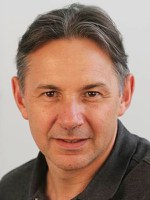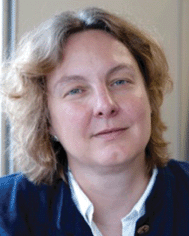The Team
Marcel Utz, University of Southampton


Prof. Marcel Utz FRSC
holds a personal chair in Magnetic Resonance, and heads the Magnetic Resonance section of the School of Chemistry. He has obtained his PhD in the groups of Prof. U.W. Suter and Richard R. Ernst (Nobel Prize in Chemistry – for NMR 1991) at ETH Zürich, Switzerland. He has held professorial appointments at the University of Connecticut (2000-2006) and the University of Virginia (2006-2012) before joining the University of Southampton in 2012. His research expertise spans complex materials, polymers and fluids, solid state nuclear magnetic resonance, and microfluididcs. Over the past five years, his group have focused extensively on the integration of NMR with microfluidic systems. Within , Prof. Utz’ group will develop NMR detection systems, as well as working closely with the Groningen groups in development of an NMR-compatible version of their microfluidic tissue slice perfusion system.
Relevant Publications
-
Leslie, Daniel C, Christopher J Easley, Erkin Seker, James M Karlinsey, Marcel Utz, Matthew R Begley, and James P Landers. “Frequency-Specific Flow Control in Microfluidic Circuits with Passive Elastomeric Features.” Nature Physics 5, no. 3 (2009): 231–35. http://dx.doi.org/doi:10.1038/NPHYS1196.
-
Utz, Marcel, and James Landers. “Magnetic Resonance and Microfluidics.” Science 330, no. 6007 (2010): 1056–58. http://dx.doi.org/10.1126/science.1198402.
-
Utz, Marcel, Matthew R Begley, and Hossein Haj-Hariri. “Microfluidic Waves..” Lab on a Chip, no. 22 no. 22 (October 21, 2011): 3846–54. http://dx.doi.org/10.1039/c0lc00426j.
-
Badilita, V., R C Meier, N Spengler, U. Wallrabe, and M Utz. “Microscale Nuclear Magnetic Resonance: a Tool for Soft Matter Research.” Soft Matter, 2012. http://dx.doi.org/10.1039/c2sm26065d.
-
Ryan, Herbert, Suk-Heung Song, Anja Zass, Jan Korvink, and Marcel Utz. “Contactless NMR Spectroscopy on a Chip.” Anal. Chem 84, no. 8 (April 17, 2012): 3696–3702. http://dx.doi.org/10.1021/ac300204z.
-
Ryan, Herbert, Alison Smith, and Marcel Utz. “Structural Shimming for High-Resolution Nuclear Magnetic Resonance Spectroscopy in Lab-on-a-Chip Devices.” Lab on a Chip 14, no. 10 (2014): 1678–85. http://dx.doi.org/10.1039/c3lc51431e.
Relevant Infrastructure:
The Magnetic Resonance Research Facility is housed jointly by the Schools of Chemistry and Biology at the University of Southampton. It comprises a state-of-the-art park of more than 10 NMR instruments, covering field strengths from 1 T to 14.1 T. Facilities include solid-state NMR systems, high resolution liquid state NMR, including a 600 MHz cryo probe, as well as imaging systems at 300 MHz and 500 MHz. Over the past two years, a dedicated cell-culture laboratory has been built in proximity of the NMR systems to support Prof. Utz’ research on microfluidic NMR. In addition, the University of Southampton is home to the Zepler institute, which runs one of Europe’s largest academic clean room facilities for micro- and nano fabrication work. Finally, the Southampton General Hospital is operated jointly by the University of Southampton and the UK NHS; it provides access to its Biomedical Research Facility, which is fully equipped for rodent-based research.
Jan Korvink, Karlsruhe Institute of Technology


Prof. Jan G Korvink FRSC
is a Chairholder at the Department of Mechanical Engineering of KIT, and the Director of the IMT. He studied Mechanical Engineering at Johannesburg and Cape Town in South Africa, and obtained his Dr. sc. techn. from the ETH Zürich in 1993.
Relevant Publications:
-
JB Hövener, N Schwaderlapp, T Lickert, S Duckett, R Mewis, L Highton, S Kenny, G Green, D Leibfritz, JG Korvink, J Hennig, D von Elverfeldt: A Hyperpolarized Equilibrium for Magnetic Resonance, Nat Commun, 2013. : http://dx.doi.org/10.1038/ncomms3946
-
RC Meier, J Höfflin, V Badilita, U Wallrabe, JG Korvink: Microfluidic integration of wirebonded microcoils for on-chip applications in nuclear magnetic resonance, J Micromech Microeng, 2014; 24 (4). : http://dx.doi.org/10.1088/0960-1317/24/4/045021
-
N Spengler, A Moazenzadeh, RC Meier, V Badilita, JG Korvink, U Wallrabe: Micro-fabricated Helmholtz coil featuring disposable microfluidic sample inserts for applications in nuclear magnetic resonance J Micromech Microeng, 2014; 24. : http://dx.doi.org/10.1088/0960-1317/24/3/034004
-
OG Gruschke, N Baxan, L Clad, K Kratt, D von Elverveld, A Peter, J Hennig, V Badilita, U Wallrabe, JG Korvink: Lab on a chip phased-array MR multi-platform analysis system, Lab Chip, 2012. : http://dx.doi.org/10.1039/C2LC20585H
-
V Badilita, B Fassbender, K Kratt, A Wong, C Bonhomme, D Sakellariou, JG Korvink, U Wallrabe: Microfabricated Inserts for Magic Angle Coil Spinning (MACS) Wireless NMR Spectroscopy, Plos One, 2012; 7 (8): e42848. : http://dx.doi.org/10.1371/journal.pone.0042848
Relevant Infrastructure:
The Institute of Microstructure Technology (IMT) at KIT features a well equipped 600 m2 microstructuring cleanroom and a large number of smaller dedicated laboratories. With five lithography systems in place (Synchrotron, E-beam, UV direct write, UV with double sided mask aligner, and 2-photon 3D nanolithography), patterning is possible starting at around 10 nm resolution, and aspect ratios of up to 100 can be achieved. The institute is well equipped with state-of-the-art simulation tools for microfluidics, micromechanics, optics, and radio frequency phenomena. The institute also possesses a hot embossing press for large area microstructuring, automatic wire bonding for microcoil manufacture, 3D printing, inkjet materials patterning including reel-to-reel facilities, laser micromachining, injection moulding, a dedicated microfluidics laboratory, a dedicated optics laboratory, state-of-the-art RF and mm-wave characterisation, state- of-the-art SEM, TEM, AFM and light microscopy facilities, large mechanical workshop, and a dedicated 11.74 T wide bore NMR. The facilities are operated by 60 permanent staff members, and are organised as the Karlsruhe Nano and Micro Facility (see www.knmf.kit.edu).
Sabeth Verpoorte, University of Groningen


Prof. Elisabeth Verpoorte
obtained her PhD in Analytical Chemistry and has almost 25 years of experience in the Lab-on-a-Chip (microfluidics) field in both industrial and academic settings in Switzerland and The Netherlands. She has been Full Professor and head of the Pharmaceutical Analysis Group, Groningen Research Institute of Pharmacy, University of Groningen, since 2003. Having worked previously with microfluidics in a more analytical chemistry context, her research focus in Groningen has turned towards the development of microfluidic systems for cell- and tissue-based analysis, particle separation, and miniaturized analytical instrumentation.
Relevant publications
-
Moon, Byeong-Ui; de Vries, Martin G.; Cordeiro, Carlos A.; Westerink, Ben H.C.; Verpoorte, Elisabeth, “Microdialysis-coupled enzymatic microreactor for in-vivo glucose monitoring in rats”, Anal. Chem. 2013, 85(22), 10949-10955.
-
Van Midwoud, Paul M.; Janse, Arnout; Merema, Marjolijn T.; Groothuis, Geny M. M.; Verpoorte, Elisabeth, “Comparison of biocompatibility and adsorption properties of different plastics for advanced microfluidic cell and tissue culture models”, Anal. Chem. 2012, 84(9), 3938-3944.
-
Van Midwoud, Paul M.; Merema, Marjolijn T.; Verweij, N.; Groothuis, Geny M.M.; Verpoorte, Elisabeth, “Hydrogel embedding of precision-cut liver slices in a microfluidic device improves drug metabolic activity”, Biotech. & Bioeng. 2011, 108(6), 1404-1412.
-
Van Midwoud, Paul M.; Janssen, Joost; Merema, Marjolijn T.; de Graaf, Inge A.M.; Groothuis, Geny M.M.; Verpoorte, Elisabeth, “On-line HPLC analysis system for metabolism and inhibition studies in precision-cut liver slices”, Anal. Chem. 2011, 83(1), 84-91.
-
Van Midwoud, P.M.; Groothuis, G.M.M.; Merema, M.T.; Verpoorte, E., “Microfluidic biochip for the perifusion of precision-cut rat liver slices for metabolism and toxicology studies”, Biotech. & Bioeng. 2010, 105(1), 184-194.